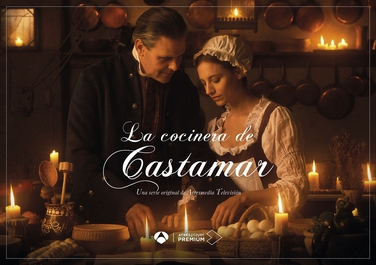![[Image description: The Palacio del Infante don Luis, the filming location for the fictional Castmar estate on Netflix's "The Cook of Castamar".] Via Wikimedia Commons.](https://blogs.stockton.edu/webtools/files/2021/10/Palacio_del_Infante_don_Luis_Boadilla_del_Monte_01a.jpg)
The Cook of Castamar came to Netflix on July 24, 2021, but it had originally aired on Spain’s Atresmedia player early this year in February (as La Cocinera de Castamar). The show is set in 1720 Madrid and follows Clara Bellmonte, played by Spanish actress Michelle Jenner, after she starts working as a cook in the kitchen of Castamar, the estate of recently widowed Duke Diego Castamar. Clara has agoraphobia, making it impossible for her to go outside. The story centers around Clara and Diego’s love story, a relationship that is forbidden by the social expectations that prohibit aristocracy from marrying the help while still being accepted in polite society.

Diego’s estate is filled with toxic, manipulative people who want to use his wife’s recent death for their own gain. While Diego represents the highest crust of aristocracy, he is truly a kind, loving man who did not see how those around him were hurting him and his potential relationship with Clara (until the end, of course).
The culture of 18th-century European aristocracy is not exclusive to Spain, but it is still a society that is different from the one we live in now. However, Spain’s culture during this time was distinctive at this time, because it was immediately after Spain’s Golden Age. The food is what makes the cultural differences stand out, particularly with Spanish cuisine (the kind of food you wouldn’t see when watching another drama about European aristocracies, like The Tudors or Pride and Prejudice). We see Clara making chorizo with another maid, or serving sopapillas for breakfast.
Despite how foreign it seems for society to judge the relationship between a maid and her boss, social stigmas still exist in the 21st century that prevents many from giving in to their feelings (like Clara and Diego for the near entirety of the show). For example, there still seems to be a stigma surrounding couples with large age gaps, no matter the gender. As outdated as it sounds, there are even cases where interracial couples still face stigma. This is perhaps one of the main reasons why Clara and Diego’s story is so compelling; everyone loves a forbidden love story, especially because we all know what it’s like to yearn for something we can’t have.
Another major similarity the show has to my own culture is the value placed on the kitchen. The kitchen is the heart of the home, and this is something Diego recognizes even though it is where the servants mainly build their relationships (he constantly finds himself below in the kitchen to see Clara). When Clara first arrives at Castamar, the housekeeper, Mercedes Berenguer, is hostile toward her and narrows in on any rumor about Clara and Diego’s relationship. What drives her character is the social cue of needing to ensure that all of society knows that she runs a good household and keeps the servants in check (social stature is a major part of this world, economically and socially, while in the 21st-century people can rise up from how they were born). By the end, however, Mercedes and Clara grow to become friends (as she becomes friends with everyone in the kitchen), and all of this happens through the bonds that form over sharing a meal at a table. This is universal, no matter the time period, location, or culture.
The characters also do the same things for fun that we do today. That includes dancing and drinking, cooking for fun, and enjoying a meal together. The types of dances and food that they eat are the only things that are different from my own culture here in the States, but the characters’ values and actions are distinctly relatable because they are simply human.
The cultural differences, on the other hand, also come with the setting and filming locations are also distinctly Spanish. The exterior shots of Castamar were shot at the Palacio del Infante don Luis, a major national cultural site outside of Madrid. In the scenes that are filmed outdoors, especially during tense scenes with horses and sword fighting (without giving away too many spoilers), the landscape is ruggedly European. Jagged hills and rocks, dense forests of the north of Spain, and dry, open plains that are brown with winter (and look like they’d be sweltering in the summer) simply look different from the kinds of plains and forests you see in America.
Another main difference from the show’s society versus that of today’s is the use of public execution as corporal punishment. Clara’s father being executed through hanging is something that you would not see in modern society. In fact, the last public execution in America was in 1936, and in Spain, it was as recently as 1972. The point of this, however, is that they don’t happen in the 21st century.
A final thing that stands out as a cultural difference is politics. At the time, Felipe V ruled Spain and is also a character in the show. Felipe V was notoriously insane and takes away Diego’s dukedom for marrying Clara in the end. This involves the politics surrounding relationships that were not society-approved in 18th century Spain.
Today, politics do not play that big of a role in frowned-upon relationships. It’s mostly social consequences, and the lingering effects that have on a love affair are something that The Cook of Castamar gets right.
Hi,
I watch a lot of Spanish speaking shows not necessarily from Spain but from Latin America. As I was reading what you shared on this blog post, this show caught my attention. Its quite evident that we(Americans)have some similar and different cultural values and beliefs those of the country of Spain. I look forward to watching this show. Thanks for sharing!